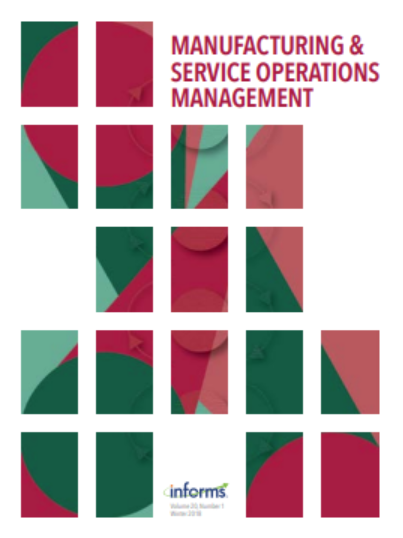面对波动市场的养猪场运营管理:库存和销售策略
IF 4.8
3区 管理学
Q1 MANAGEMENT
M&som-Manufacturing & Service Operations Management
Pub Date : 2023-09-01
DOI:10.1287/msom.2023.1216
引用次数: 0
摘要
问题定义:我们研究了一个猪肉生产商的动态屠宰阶段计划问题,该生产商在每周开始时可以看到她有多少可供销售的猪和当前的市场价格。然后,她必须决定将哪些猪卖给肉类加工厂并在公开市场上出售,哪些猪保留到下一周。根据合同规定,农民每周向肉类加工厂交付固定数量的生猪,价格根据合同规定的市场指数确定。如果农民向肉类加工商交付的货物不足,她将支付合同规定的单位罚款,该罚款也与市场指数挂钩。生物安全协议禁止农民在公开市场上购买生猪并将其出售给肉类加工厂。然而,农民可以利用公开市场以现行市场价格出售生猪。方法/结果:我们将该问题视为具有多个不确定性来源的动态、多项目、非平稳库存问题。最优策略是具有多个价格相关阈值的阈值策略。评估阈值所需的计算复杂性是使用最优策略作为决策支持工具的最大障碍。因此,我们利用近似动态规划方法,利用最优策略结构并产生易于实现的尖锐启发式。管理意义:根据猪肉生产商的数据校准的数值实验表明,启发式估计阈值的最优政策大大改善了现有的做法(平均约25%)。该模型的成功归功于认识到持有低重量生猪的价值,并有效地对冲了供应不确定性和未来价格——这是当前实践中规划行动中遗漏的洞察力。补充材料:在线附录可在https://doi.org/10.1287/msom.2023.1216上获得。本文章由计算机程序翻译,如有差异,请以英文原文为准。
Managing Operations of a Hog Farm Facing Volatile Markets: Inventory and Selling Strategies
Problem definition: We study a dynamic finishing-stage planning problem of a pork producer who at the beginning of each week gets to see how many market-ready hogs she has available for sale and the current market prices. Then, she must decide which hogs to sell to a meatpacker and on the open market and which hogs to hold until the following week. The farmer is contracted to deliver a fixed quantity of hogs to the meatpacker each week priced according to a contractually predetermined market index. If the farmer underdelivers to the meatpacker, she pays a contractually predetermined unit penalty also linked to a market index. Biosecurity protocols prevent the farmer from buying hogs on the open market and selling them to the meatpacker. The farmer can, however, use the open market to sell hogs for prevailing market prices. Methodology/Results: We treat the problem as a dynamic, multiitem, nonstationary inventory problem with multiple sources of uncertainty. The optimal policy is a threshold policy with multiple price-dependent thresholds. The computational complexity required to evaluate the thresholds is the biggest impediment to using the optimal policy as a decision-support tool. So, we utilize an approximate dynamic programming approach that exploits the optimal policy structure and produces a sharp heuristic that is easy to implement. Managerial implications: Numerical experiments calibrated to a pork producer’s data reveal that the optimal policy with the heuristically estimated thresholds substantially improves the existing practice (around 25% on average). The success of the proposed model is attributed to recognizing the value of holding underweight hogs and effectively hedging supply uncertainty and future prices—an insight missed in the planning actions of the current practice. Supplemental Material: The online appendix is available at https://doi.org/10.1287/msom.2023.1216 .
求助全文
通过发布文献求助,成功后即可免费获取论文全文。
去求助
来源期刊

M&som-Manufacturing & Service Operations Management
管理科学-运筹学与管理科学
CiteScore
9.30
自引率
12.70%
发文量
184
审稿时长
12 months
期刊介绍:
M&SOM is the INFORMS journal for operations management. The purpose of the journal is to publish high-impact manuscripts that report relevant research on important problems in operations management (OM). The field of OM is the study of the innovative or traditional processes for the design, procurement, production, delivery, and recovery of goods and services. OM research entails the control, planning, design, and improvement of these processes. This research can be prescriptive, descriptive, or predictive; however, the intent of the research is ultimately to develop some form of enduring knowledge that can lead to more efficient or effective processes for the creation and delivery of goods and services.
M&SOM encourages a variety of methodological approaches to OM research; papers may be theoretical or empirical, analytical or computational, and may be based on a range of established research disciplines. M&SOM encourages contributions in OM across the full spectrum of decision making: strategic, tactical, and operational. Furthermore, the journal supports research that examines pertinent issues at the interfaces between OM and other functional areas.
 求助内容:
求助内容: 应助结果提醒方式:
应助结果提醒方式:


